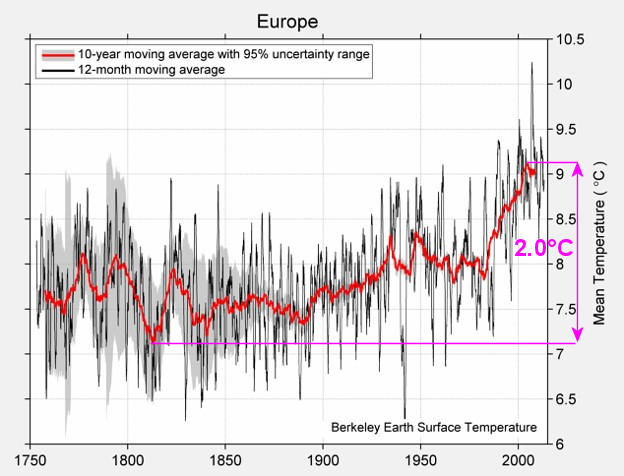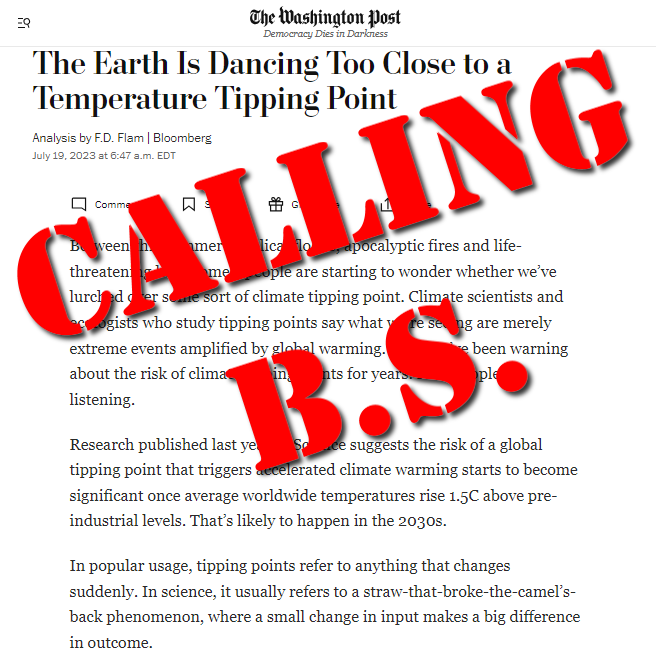A recent opinion piece in The Washington Post (WaPo), titled The Earth Is Dancing Too Close to A Temperature Tipping Point is so factually inaccurate that it merits calling BS on it. The article is false. Tipping points have not occurred in modern times related to climate change and in fact, the claimed 1.5-degree centigrade temperature that is supposed to trigger the tipping point has already been surpassed with no measurable ill effects.
In the article by F.D. Flam of Bloomberg, he writes:
Between this summer’s biblical floods, apocalyptic fires and life-threatening heat domes, people are starting to wonder whether we’ve lurched over some sort of climate tipping point. Climate scientists and ecologists who study tipping points say what we’re seeing are merely extreme events amplified by global warming. But they’ve been warning about the risk of climate tipping points for years. Now people are listening.
Research published last year in Science suggests the risk of a global tipping point that triggers accelerated climate warming starts to become significant once average worldwide temperatures rise 1.5C above pre-industrial levels. That’s likely to happen in the 2030s.
While tipping points in Earth’s climate have occurred before in the planet’s history, such as Ice Ages, they occurred naturally, without any human intervention. Yet the author cites so-called expert opinion to suggest that we’re already flirting with tipping points. He provides no evidence or basis to substantiate this claim, because there is none.
Timothy Lenton, chair in climate change and earth system science at the University of Exeter, told Flam that the extreme events making the news this summer might represent an early warning sign he calls ‘”flickering” — a brief visit to the other side of a tipping point.
“A complex system can sometimes start to sample a different regime or state before it takes a more permanent shift into that state,” Lenton said. “I hope it’s not the case.”
Climate at a Glance: Tipping Point – 1.5 Degrees Celsius Warming, succinctly puts the lie to his concerns, pointing out:
- Climate alarmists (and the IPCC) say we need to limit global warming to 1.5°C above pre-industrial times to avoid disastrous consequences, but data show we have already reached such temperatures.
- European temperature data show temperatures began rising about the year 1890. (Note that this was before the large modern rise in CO2 emissions.)
- As shown in this Climate at a Glance series, as well as by the U.N. Intergovernmental Panel on Climate Change, catastrophic predictions of extreme climate change have not come true.
The bottom line is that large portions of Earth have already experienced A 1.5°C temperature rise according to temperature data. Europe possesses the best, longest-running temperature records on the planet, and those temperature records show warming has already exceeded 1.5°C, yet alarmists’ disaster predictions have not come true.
Figure 1 is the Berkeley Earth average surface temperature record for Europe. Europe is a good location to analyze, because some of the longest continuous temperature records are from Europe. It shows that not just 1.5°C, but 2.0°C of warming has already occurred. Yet, despite that warming, catastrophic tipping points have not occurred.

Climate alarmists, such as Flam, warn we must take drastic steps within the next 10 years to keep warming to below or near 1.5°C above pre-industrial conditions. They claim that warming beyond that 1.5°C threshold will unleash a crisis of substantially worse extreme weather events and other climate harms. Nevertheless, alarmists’ catastrophic predictions are not coming true, and history shows they have been wrong for decades. Climate Realism reported on the lack of “tipping point” occurrences the article, Media Can’t Agree on the Number of Climate Tipping Points, Much less When, for example.
It is important to note that the 1.5°C threshold is an arbitrary number, and it is not defined by science. It was defined by political negotiations in the Paris Accord agreement of 2015. An Associated Press article, The magic 1.5: What’s behind climate talks’ key elusive goal, admits this stating, “in a way both the ‘1.5 and 2 degree C thresholds are somewhat arbitrary,’ Stanford University climate scientist Rob Jackson said in an email. ‘Every tenth of a degree matters!’”
If every 10th of a degree mattered, according to the data from Europe in Figure 1, we should already have seen “climate catastrophes” occur, represented by trends in increases of extreme weather events. But there are no such trends. Temperatures we are witnessing this summer in the northern hemisphere are simply weather events which have occurred before. Some of the claims about record breaking temperatures have proved laughably false.
The idea of disastrous “tipping points” may make for good headlines and story ledes, but there is no evidence any exist. There is no reason for believing that humans face any catastrophic tipping points now and certainly no reason to believe WaPo’s opinion page.


















No caged bird. No puppy. No need for WaPo.